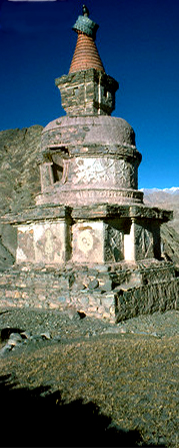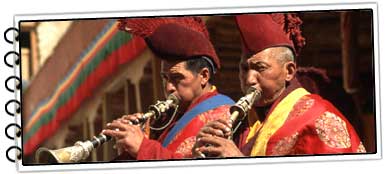
Ladakh Tour - offers tours to Ladakh, LadakhTour Package, Ladakh Cultural Tour, Cycling in Leh & Ladakh.
Ladakh is bounded by world's two mightiest mountain ranges the great Himalayan and the Karakoram, It lies athwart two others The Ladakh and the Zangskar range.
It leaves the first time traveler awestruck by its geographical and cultural difference as they land at Leh. The features of Ladakhi people, their clothes and dialects are similar to Tibetan and Mongoloid then Indian.
It leaves the first time traveler awestruck by its geographical and cultural difference as they land at Leh. The features of Ladakhi people, their clothes and dialects are similar to Tibetan and Mongoloid then Indian.
Ladakh Tour

Home - Ladakh Tourism
Ladakh Tourism
The geographical backbone of Ladakh, the Inuds Valley, particularly from Upshi down to Khalatse, is
 also the region's histocric heartland. All the major sites connected with the former kingdom's dynastic history are here, starting with Leh, the capital city since the early 17th century when Sengge Namgyal built its nine-storey palace.
A few kilometres up the Indus is Shey, the most ancient capital, with its palace and temples, their vibrantly coloured murals cleaned and restored in the mid-1980s. Down river, Basgo, right on the road and Tingmosgang, a short way up a side-valley, both served as capital cities when the country was temporarily divided into two parts in the 15th century, and both have the remains of forts and temples dating from the period of their brief glory.
Stok, just across the river from Leh, is the village with which the deposed royal family was compensated for the loss of its throne. Its palace houses a museum of artefacts associated with the dynasty, and there is also a small gompa.
also the region's histocric heartland. All the major sites connected with the former kingdom's dynastic history are here, starting with Leh, the capital city since the early 17th century when Sengge Namgyal built its nine-storey palace.
A few kilometres up the Indus is Shey, the most ancient capital, with its palace and temples, their vibrantly coloured murals cleaned and restored in the mid-1980s. Down river, Basgo, right on the road and Tingmosgang, a short way up a side-valley, both served as capital cities when the country was temporarily divided into two parts in the 15th century, and both have the remains of forts and temples dating from the period of their brief glory.
Stok, just across the river from Leh, is the village with which the deposed royal family was compensated for the loss of its throne. Its palace houses a museum of artefacts associated with the dynasty, and there is also a small gompa.
Partly as a result of royal patronage, the central area of Ladakh has the greatest concentration of major gomps. Of the twelve situated on or near the Inuds, the is Lamayuru, believed to have been a sacred site for the pre-Buddhist religion known as Bon. Phiyang, Hemis and Chemrey were all founded under the direct partonage of members of the ruling Namgyal dynasty. Phiyang represents an act of penance by the 16th century King Tashi Namgyal for the violence and treachery by which he reached the throne. Hemis, together with Hanle near the Tibetan border, was founded at the instance of King Sengge Namgyal, and Chemrey by his widow as a posthumous act of merit for him. Stakna, dating from a slightly earlier period, was endowed by the Namgyal kings at various times. All these belong to the red-hat Kar-gyut-pa sect of Tibetan monasticism.
The reformist Ge-lugs-pa (Yellow-hat) sect is also well represented in central Ladakh by Thikse, Likir, Ridzong and Spituk, the last of which hasdaughter houses at Stok, Sabu and Sankar. Ri-dzong, the only gompa which is not as yet approachable by a motorable road, is situated a few kilometres up a side- valley at Uley-Tokpo. It was founded only a century and a quarter ago by a devout layman-turned-lama, with the purpose of giving full expression to the strict monastic rule of the Ge-lugs-pa. While the paintings and images in its temples may, to some extent, lack the aesthetic and antiquaian interest of those inthe older establishments, this gompa nevertheless has an indefinable atmoshpere of peace and dedication which reflects faithfully the inwardness of the Buddhist Way. The smaller but much older Bying-ma-pa and Saskya-pa monastic sects are represented respectively by Tak-thok and Matho gompas. Takthok, at the foot of the Chang-la, incorporates one of the many caves in the Himalaya where the Indian Buddhist apostle Padma-sambhava is said to have rested and meditated on his journey to Tibet. Matho Gompa has a slightly rundown structure, but a vibrant religious community. It is famous for its festival of the oracles which takes place early in the year, usually in the first half of March.
But the jewel among central Lakakh's religious sites is Alchi. Abandoned centuries ago as a place of regular worship, it has been lovingly maintained by the monks of Likir, the nearest functioning gompa. Known as Chos-kor, or religious enclave, it comprises five temples, the riches in paintings and images being the Du-khang(assembly hall) and the threestorey Sum-tsek. Its murals, dating from the 11th and 12th centuries, pre-date the Tibetan style of painting that is present in all the other gompas. Some of them are reminiscent of the paintings of the far-off Ajanta Caves and are presumed to be almost the sole survivors (along with some in Phugtal Gompa in Zanskar, and Tabo in Spiti) of the Buddhist style current in Kashmir during the first millennium AD.
Ladakh Historical Background
For close on 900 years from the middle of the 10th century, Ladakh was an independent kingdom , its dynasties descending from the king of old Tibet. Its political fortunes ebbed and flowed over the centuries, and the kingdom, was at its greatest in the early 17th century under the famous king Sengge Namgyal, whose rule extended across Spiti and western Tibet up to the Mayumla beyond the sacred sites of Mount Kailash and Lake Mansarovar. And gradually, perhaps partly due to the fact that it was politically stable, in contrast to the lawless tribes further west, Ladakh became recognized as the best trade route between the Punjab and Central Asia. For centuries it was travered by caravans carrying textiles and spices, raw silk and carpets, dyestuffs and narcotics. Heedless of the land's rugged terrain and apparent remoteness, merchants entrusted their goods to relays o fpony transporters who took about two months to carry them from Amritsar to the Central Asian towns of Yarkand and Knotan. On this long route, Leh was the half-way house, and developed into a bustling entreport, it bazaars thronged with merchants from far countries. The famous pashm (better known as cashmere) also came down from the high-altitude plateaux of eastern Ladakh and western Tibet where it was produced, thorough Leh to Srinagar, where skilled artisans transformed it from a matted oily mass of goat's underfleece into shawls known the world over for their softness and warmth. Ironically, it was this lucrative trade, that finally spelt the doom of the independent kingdom. It attracted the covetous gaze of Gulab Singh, the ruler of Jammu in the early 19th century, and in 1834, he sent his general Zorawar Singh to invade Ladakh. They followed a decade of war and turmoul, which ended with the emergence of the British as the paramount power in north India. Ladakh, together with the neighbouring province of Baltistan, was incorporated into the newly created State of Jammu & ashmir.Just over a century later, this union was disturbed by the partition of India, Baltistan becoming part of Pakistan, while Ladakh remained in India as part of the State of Jammu & Kashmir.
Ladakh Ancient Routes
For all its seeming inaccessibility, Ladakh's position at the centre of a network of trade routes traditionally kept it in constant touch withthe outside world. From Chinese Central Asia,the mighty Karakoram range was breached at the Karakoram pass, a giddy 18,350 feet (5,600m). The trail from Yarkand crossed five other passes, of which the most feared was the glacier, encumbered Saser-la, north of Nubra. Travellers from Tibet could take one of two main routes. From the central part of the country, the Tsang-po valley, they could pass the holy sites of Kailash-Mansarovar and reach Fartok, on a tributary of the upper Indus, from where they followed the river down to Leh. Trade with the pashm producing areas of western Tibet flowed by a more northerly route, taking in the village of Rudok, a few miles into Tibet, and from there across the 18,300 feet (5,578m ) Chang-la to the Indus, and so to Leh.Baltistan, joined administratively with Ladakh for 100 years, was linked to it either via the Indus up to its confluence with the Suru-Shingo river, and on up to Kargil; or by the Chorbat-la pass over the Ladakh range, the trail dropping down to the Indus 40 km below Khalatse, and following the river up to Leh.
The two main approaches toLadakh from south of the Himalaya are roughly the same as today's motor roads from Srinagar and Manali. The merchants and pilgrims who made up the majority of travellers in the premodern era, travelled on foot or horseback, taking about 16 days to reach Srinagar; though a man in hurry, riding non-stop and with changes of horse arranged ahead of time all along the route, could do it in as little as three days. The mails, carried in relays by runners stationed every four miles or so, took four or five days. That was before the wheel as a means of transport was introduced into Ladakh, which happened only when the Srinagar- Leh motor-road was constructed as recently as the early 1960s.
